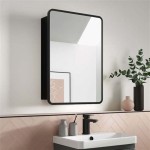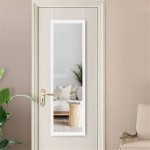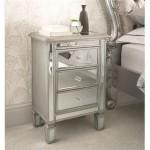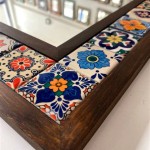Hanging a Mirror on Drywall: A Comprehensive Guide
Hanging a mirror on drywall presents a common challenge for many homeowners. Drywall itself is not structurally designed to support significant weight, making it crucial to employ the correct techniques and hardware to ensure the mirror is securely fastened and remains in place. This article provides a detailed guide to hanging mirrors on drywall, covering essential preparations, hardware options, and step-by-step instructions.
Understanding Weight Limitations and Safety Precautions
Before attempting to hang a mirror, it is imperative to assess its weight and the capabilities of the drywall. Drywall's weight-bearing capacity is relatively low, typically around 5-10 pounds without reinforcement. Exceeding this limit can lead to the mirror detaching from the wall, potentially causing damage and injury. It is critical to use a stud finder to locate wall studs, as these provide significantly stronger support. If mounting without studs is necessary, specialized drywall anchors designed for heavier loads should be utilized.
Safety is paramount throughout the entire process. Wear safety glasses to protect the eyes from debris during drilling or hammering. When handling mirrors, use work gloves to ensure a secure grip and prevent cuts from sharp edges. Employ a helper, especially for larger or heavier mirrors, to assist with lifting and positioning. Always disconnect power to any electrical outlets or switches in the immediate vicinity of the mounting area to avoid electrical shock. Carefully read and adhere to the manufacturer's instructions for all hardware used.
Prior to installation, thoroughly inspect the mirror's hanging hardware. Ensure D-rings, wire, or other mounting mechanisms are securely attached to the mirror frame and are in good working order. Damaged or flimsy hardware should be replaced before proceeding. Take precise measurements of the mounting points on the mirror to accurately mark the corresponding locations on the wall.
Selecting the Appropriate Hardware
Choosing the right hardware is vital for a secure and long-lasting installation. The weight and size of the mirror, as well as the presence or absence of wall studs, will dictate the appropriate hardware options. Several types of anchors are available specifically for drywall, each with varying load capacities.
Wall Studs: If a wall stud is accessible, this is the preferred method for hanging a mirror. Simply use wood screws long enough to penetrate the drywall and securely embed into the stud. The length of the screw should be at least 1.5 inches to ensure adequate grip within the stud. Predrilling a pilot hole can help prevent the wood from splitting.
Drywall Anchors: When studs are not available, drywall anchors offer a viable alternative. Different types of drywall anchors include:
- Plastic Anchors: These are suitable for very lightweight mirrors (under 5 pounds). They are easy to install but offer minimal holding power.
- Self-Drilling Anchors (Molly Bolts): These anchors have a sharp point that allows them to be screwed directly into drywall without pre-drilling. They expand behind the drywall to provide a more secure hold and can support medium-weight mirrors (up to 20 pounds).
- Toggle Bolts: Toggle bolts are the strongest type of drywall anchor and are recommended for heavier mirrors (up to 50 pounds). They consist of a bolt and a spring-loaded wing that expands behind the drywall. To install, a relatively large hole needs to be drilled in the drywall to accommodate the folded wings. Once inserted, the wings spring open to provide a wide, secure base.
- Snap Toggle: These anchors are similar to toggle bolts, but they have a plastic strap that helps keep the toggle centered while inserting the bolt. They are a good choice for heavier mirrors and are available in various sizes and weight ratings.
It is crucial to consult the manufacturer's specifications for each type of anchor to determine its weight capacity and ensure it is appropriate for the mirror being hung. Always use anchors that are rated to support at least the weight of the mirror, plus a safety margin.
Step-by-Step Installation Guide
The following steps outline the process of hanging a mirror on drywall, assuming that the necessary planning and preparation have been completed.
Step 1: Locate Wall Studs (If Applicable): Use a stud finder to locate wall studs in the desired mounting area. Mark the location of the stud with a pencil. Verify the stud location by tapping the wall; a solid sound indicates the presence of a stud. If hanging on a stud, skip to Step 4.
Step 2: Mark Anchor Points (If Not Using Studs): Determine the desired location for the mirror on the wall. Use a level to ensure the mirror will be hung straight. Mark the locations for the anchor points on the wall, referring to the measurements taken earlier from the mirror’s mounting hardware. For mirrors with two mounting points, ensure the marks are level with each other.
Step 3: Install Drywall Anchors (If Not Using Studs): Select the appropriate type of drywall anchor based on the weight of the mirror. Follow the manufacturer's instructions for installing the selected anchor. This may involve pre-drilling a hole of a specific size or directly screwing the anchor into the wall. For toggle bolts, remember to drill a larger hole to accommodate the wings.
Step 4: Install Screws or Hooks: Once the anchors are in place (or the stud is located), install screws or hooks into the anchors (or the stud). Leave a small portion of the screw or hook exposed to allow the mirror to be hung securely. When using screws, ensure they are long enough to penetrate the anchor or stud adequately.
Step 5: Hang the Mirror: Carefully lift the mirror and align the hanging hardware (D-rings, wire, etc.) with the screws or hooks on the wall. Gently lower the mirror onto the screws or hooks, ensuring it is securely supported. Double-check that the mirror is hanging straight using a level.
Step 6: Verify Stability: After hanging the mirror, gently tug on it to ensure it is securely attached to the wall. If the mirror moves excessively or the anchors appear to be pulling out of the drywall, remove the mirror and reinforce the installation. This may involve using larger or stronger anchors or relocating the mirror to a different area of the wall.
Additional Considerations: For particularly heavy or valuable mirrors, consider consulting with a professional installer. They have the experience and tools to ensure a safe and secure installation. When hanging multiple mirrors, maintain consistent spacing and alignment for a visually appealing arrangement. Regularly inspect the mounting hardware and the wall around the mirror for any signs of loosening or damage. Tighten screws or replace anchors as needed to maintain the stability of the installation.
By carefully considering these factors and following the steps outlined above, homeowners can successfully and safely hang mirrors on drywall, enhancing their home decor and creating a visually appealing and functional space.

How To Hang A Heavy Mirror On Drywall Stas Picture Hanging Systems
How To Hang A 100 Pound Mirror On Drywall Quora

How To Hang A Heavy Mirror Diy Family Handyman

How To Hang A Large Or Heavy Mirror

How To Hang A Heavy Mirror With French Cleat

How To Hang A Very Heavy Picture Or Mirror The Best

How To Hang A Heavy Mirror Or Picture True Value

How To Hang A Heavy Mirror Securely Bob Vila

How To Hang A Heavy Mirror

How To Hang A Heavy Mirror On Drywall Stas Picture Hanging Systems








